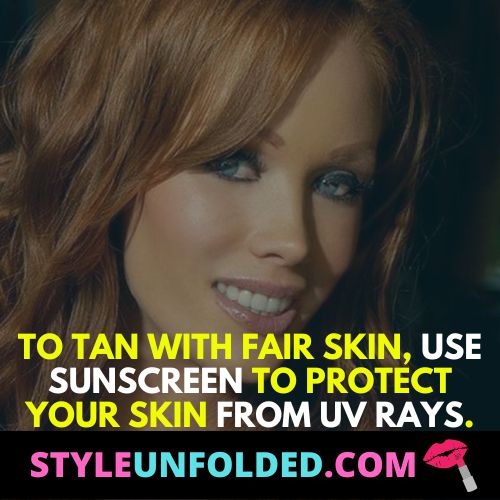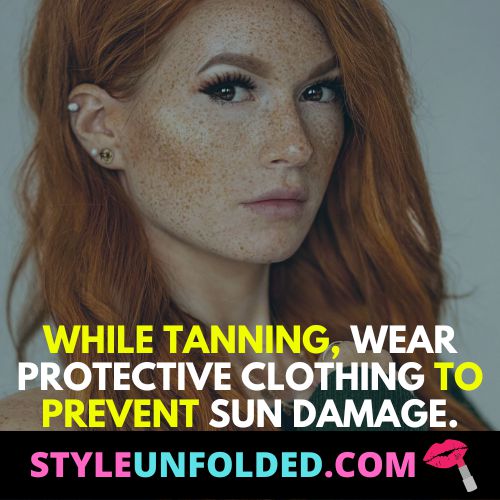Are you tired of avoiding the sun and missing out on that summer glow due to your fair skin and freckles? Well, fear not, because it’s possible to achieve a beautiful, natural-looking tan without compromising your skin’s health. With the right techniques and precautions, you can safely and effectively get your skin glowing in no time.
wondering, how to tan with fair skin and freckles? We’ve got the expert tips and tricks you need to achieve a beautiful tan without damaging your skin. From the right sunscreen to the perfect tanning technique, we’ve got you covered.
So, let’s dive in and get your skin glowing!
How to Tan with Fairs Skin and Freckles
To tan with fair skin and freckles, start by using broad-spectrum sunscreen with an SPF of at least 30 before heading outdoors. Gradually increase your exposure to the sun, starting with short sessions of 10-15 minutes and taking breaks in the shade to avoid overexposure. Stay hydrated and moisturize your skin regularly to prevent dryness or flaking. By following these tips, you can achieve a gorgeous, natural-looking tan without compromising your skin’s health.
1. Understanding Fair Skin and Freckles
Fair skin is more susceptible to sun damage, and freckles can increase the risk of skin cancer. It’s important to understand your skin type and take appropriate precautions when tanning.
2. Pre-Tan Preparations for Fair Skin
Before you tan, it’s important to prepare your skin. Exfoliating your skin with a gentle scrub will remove dead skin cells and help your tan last longer. Moisturizing your skin will keep it hydrated and healthy.
3. Using Sunscreen to Protect Your Skin
Wearing sunscreen is essential for protecting your skin from harmful UV rays. Choose a broad-spectrum sunscreen with an SPF of at least 30 and reapply it every two hours. If you’re going to be in the water, use waterproof sunscreen.

4. Optimum Tanning Time for Fair Skin
The best time to tan is during the early morning or late afternoon when the sun’s rays are less intense. Avoid tanning during peak hours when the sun is at its strongest. Start with short tanning sessions and gradually increase the time as your skin gets used to it.
5. Gradual Tanning Products for a Natural Look
Gradual tanning products are a great option for those with fair skin. They gradually build up a tan over time and give you a natural-looking glow. Look for products that contain natural ingredients and are free from harsh chemicals.
6. How to Tan with Self-Tanner
Self-tanners are another great option for those with fair skin. They give you a tan without the need for UV exposure. Choose a self-tanner that matches your skin tone, and apply it evenly using a mitt or gloves.
7. Using Tanning Beds Safely for Fair Skin
Tanning beds are not recommended for those with fair skin as they can increase the risk of skin cancer. However, if you choose to use a tanning bed, make sure to follow safety guidelines and use it in moderation.
8. Staying Hydrated for a Healthy Tan
Drinking plenty of water is essential for keeping your skin hydrated and healthy. Dehydrated skin is more susceptible to sun damage and can cause your tan to fade more quickly.

9. Wearing Protective Clothing and Accessories
Wearing protective clothing and accessories can help prevent sun damage. Wear a wide-brimmed hat and sunglasses to protect your face, and cover up with a long-sleeved shirt and pants when possible.
10. Proper Skincare After Tanning
After tanning, it’s important to take care of your skin to keep it healthy. Moisturize your skin to keep it hydrated and apply after-sun lotion to soothe any redness or irritation. Avoid exfoliating your skin for at least a few days after tanning.
Related Posts:
How to Tan Without Burning Fair Skin
To tan without burning fair skin, it’s essential to protect your skin from the harmful UV rays of the sun. Use broad-spectrum sunscreen with an SPF of at least 30 and reapply it every two hours. Take frequent breaks in the shade and avoid spending too much time in the sun during peak hours. Gradually increase your exposure to the sun to help your skin adapt, and stay hydrated to keep your skin healthy. By following these tips, you can achieve a beautiful, healthy tan without burning your fair skin.
Want to get a tan without burning your fair skin? Read on for some simple tips to help you achieve a natural-looking glow without damaging your skin.
1. Understanding Your Skin Type and Sun Exposure
Knowing your skin type and how much sun exposure it can handle is key to tanning safely. Fair skin is more prone to sunburn and skin damage, so it’s important to take extra precautions when tanning.
2. Pre-Tanning Preparations to Prevent Sunburn
Before tanning, it’s important to prepare your skin by exfoliating and moisturizing it. This will help your tan last longer and prevent sunburn.

3. Choosing the Right Sunscreen and Application
Using sunscreen is essential for protecting your skin from harmful UV rays. Choose a broad-spectrum sunscreen with an SPF of at least 30 and reapply it every two hours. Apply it evenly all over your body, including hard-to-reach areas.
4. Optimum Tanning Time and Frequency for Fair Skin
Tanning during peak hours when the sun is strongest can increase the risk of sunburn and skin damage. Start with short tanning sessions and gradually increase the time and frequency as your skin gets used to it.
5. Alternatives to Sun Tanning for Fair Skin
If tanning in the sun isn’t an option, there are alternative ways to achieve a natural-looking tan. Self-tanners and gradual tanning products can give you a healthy glow without the risk of sun damage.
Popular Posts:
- Spray Tan Showering Dos and Don’ts: A Guide to Keeping Your Tan Intact
- The Aftermath: What to Do After a Spray Tan
How Can I Tan My Fair Skin Naturally
To tan your fair skin naturally, you should start with short sessions of sun exposure, gradually increase the time, wear protective clothing, use sunscreen, take frequent shade breaks, and stay hydrated. Read on to discover how you can achieve a natural-looking tan without harming your skin.
1. Gradual Sun Exposure
To tan your fair skin naturally, it’s crucial to start with short sessions of sun exposure and gradually increase the time over a few weeks. This approach will help your skin adapt to the sun and reduce the risk of burning or damaging your skin.
2. Broad-Spectrum Sunscreen
Protecting your skin from the sun’s harmful rays is essential when tanning your fair skin naturally. Use broad-spectrum sunscreen with an SPF of at least 30 and reapply it every two hours or more frequently if you are sweating or swimming.
3. Protective Clothing and Accessories
Wearing protective clothing and accessories, such as a wide-brimmed hat, sunglasses, and long-sleeved shirts, can also help shield your skin from the sun and prevent burning or damage.
4. Frequent Shade Breaks
Take frequent breaks in the shade to avoid overexposure to the sun. This will give your skin time to cool down and recover, reducing the risk of burning or damage.
5. Hydration and Moisturization
Staying hydrated and moisturizing your skin regularly can also help keep your skin healthy and prevent dryness and flaking. Drink plenty of water and use a moisturizer that is compatible with your skin type to maintain its health and elasticity.
Most Read:
- Spray Tan-Ready: The Ultimate Guide on What to Wear to a spray Tan
- When Can I Shower After a Spray Tan
FAQs
Why Do I Get More Freckles When I Tan?
When you tan, your skin produces more melanin, which is the pigment that gives color to your skin. This increase in melanin production can cause your freckles to become more pronounced and noticeable. Freckles are clusters of melanin that are more concentrated in certain areas of your skin, and when your skin tans, these clusters become more visible.
It’s important to note that excessive sun exposure can also lead to sun damage and increase the risk of skin cancer. To prevent damage and protect your skin, use a broad-spectrum sunscreen and limit your time in the sun. Additionally, consider using products like hats and protective clothing to shield your skin from the sun’s harmful rays. By taking these precautions, you can enjoy the sun safely without exacerbating your freckles.
Do Freckles Get Darker When You Tan?
Yes, freckles can get darker when you tan. Freckles are caused by the accumulation of melanin, which is the pigment that gives color to our skin. When you expose your skin to the sun, it triggers the production of more melanin, which can cause your freckles to become more pronounced and darker in color. It’s important to note that excessive sun exposure can also lead to sun damage and increase the risk of skin cancer. To prevent damage and protect your skin, use a broad-spectrum sunscreen and limit your time in the sun.
Additionally, consider using products like hats and protective clothing to shield your skin from the sun’s harmful rays. By taking these precautions, you can enjoy the sun safely without exacerbating your freckles.
How Long Does It Take to Tan with Pale Skin?
The time it takes to tan pale skin varies depending on several factors, such as your skin type, the intensity of the sun, and the amount of melanin present in your skin. However, it typically takes around two to three weeks of consistent sun exposure to see a noticeable difference in skin tone. It’s essential to practice safe sun habits and use sunscreen to protect your skin from burning and long-term damage.
Conclusion
Getting a tan with fair skin and freckles can be a challenge, but it’s not impossible. With these tips and precautions, you can get a healthy and natural-looking tan without risking sun damage or skin cancer. Remember to be patient, take it slow, and prioritize your skin’s safety above everything else.
Leave a Reply